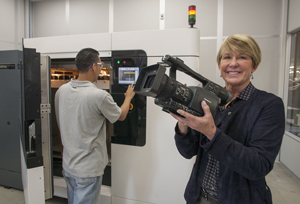
Though Los Angeles is still a manufacturing powerhouse, its industrial workforce is shrinking – and aging.
Some employers fear they might soon lose workers skilled in arcane processes that they mastered from decades on the job. In response, they are taking dramatic and even creative steps to train the next generation of workers.
At Torrance aerospace manufacturer ACE Clearwater Enterprises, where half of its 200 employees are older than 46 and one-tenth are older than 61, that meant investing $1 million in several strategies to build a new workforce. In the process, Kellie Johnson, its president, even came up with a side business.
Johnson formed Dash 9 Productions Inc., a video production company specializing in documenting the knowledge and skills of older workers so they can be used to train new hires. Presumably, the videos will be good for years – well after today’s skilled workers retire.
For ACE, the videos help train young and new employees how to make highly customized metal parts for aerospace and defense customers.
“We use very old, cost-effective techniques – we do short runs, low volume – and lots of different configurations at one time, so they can’t be automated,” she said. “Pretty much everything we make is hand-crafted.”
Johnson said that other manufacturers were in the same predicament, and Dash 9 began producing training videos for them. It has become a new revenue stream for ACE.
At ACE, Dash 9’s videos are a mix of interviews with machine operators, often those who use older drop-hammer presses and newer laser-cutting machines, and animations that illustrate basic operations. The videos now play a role in the company’s newer emphasis on mentoring, Johnson said.
“The difference between now and 10 years ago is we’re doing more mentoring and training now,” she said.
The company has found that new and younger hires require more mentoring and training than people brought in a decade ago. The reason, she said, is that high schools eliminated shop classes in drafting, and wood and metal shop, and didn’t replace them with classes teaching today’s jobs.
“This gap means new hires require more time to integrate into the manufacturing environment,” she said.
‘Broadest problem’
Even as the L.A. manufacturing sector has seen employment fall to 366,000 people last year from 615,000 in 2000, a 40 percent decline, it still remains an economic powerhouse – but one in need of skilled employees.
Yet training programs are having a hard time attracting younger workers, and a lack of job candidates with hands-on technical experience with machines and mathematical measurements is “the broadest problem of our manufacturing base in California,” said Gino DiCaro, vice president of communications for California Manufacturers & Technology Association, a Sacramento trade group representing the state’s $230 billion manufacturing industry.
“Workforce problems certainly start with an aging workforce, but are further complicated by a general neglect of career technical education in our public high schools over past decades,” DiCaro said. “The loss of programs to teach students to work with their hands, especially in Los Angeles, which is a substantial manufacturing region, means rebuilding a world-class manufacturing workforce is an even bigger challenge.”
Adding to the challenge for Johnson is competition for younger workers from large companies that offer higher salaries. She noted that a position that pays about $15 an hour at ACE pays $20 an hour at Honeywell International Inc., one of ACE’s customers.
“We’re trying to attract the best and our customers are trying to do the same thing,” she said.
Equally challenging is trying to change a common perception that a manufacturing career is low skilled with no future.
“I think we have an outdated perception of manufacturing,” Johnson said. “Most people think we don’t make things anymore. Surveys show many people think we need manufacturing, but most people don’t want their kids to go into manufacturing.”
Jose Anaya, dean of community advancement with El Camino College in Torrance, a community college with a manufacturing program, also oversees advanced manufacturing programs for all the state’s community colleges.
He said that he feels efforts such as those backed by downtown L.A.’s Reliance Steel & Aluminum Co., which has been supporting a nonprofit group that trains military veterans in skills used at its businesses or the manufacturers they sell to, are working because they create awareness.
“What young people discover is that they want to work with their hands and build stuff, and that isn’t going on without these programs,” Anaya said.
Three years ago, Reliance was shocked into action when managers realized that one-quarter of its nearly 15,000 employees planned to retire in the next five to 10 years.
“At one (portfolio) company, over 60 percent of its workforce was over 50,” said Brenda Miyamoto, vice president of corporate initiatives. Having those numbers up there (on a screen) created a sense of urgency.”
As a result, Reliance started supporting San Diego-based Workshops for Warriors, which trains veterans on machining and welding, skills needed at Reliance and its customers.
“Part of the issue is not just how to engage the next generation of workers in our field but finding ones that are adequately trained,” she said.
DiCaro said manufacturers are increasingly turning to the association to help them train existing employees on the new technologies they need to stay competitive.
“California’s average manufacturing wage is $25,000 higher than its average service jobs’ wage, so it’s critical we pay attention to what helps a manufacturer grow in California,” DiCaro said. “One of most significant factors in a manufacturer’s decision to put bolts in the ground and scale up is an available and skilled workforce.”
